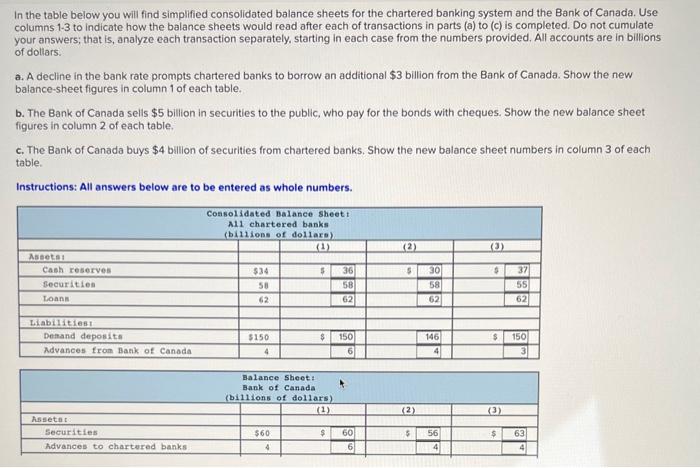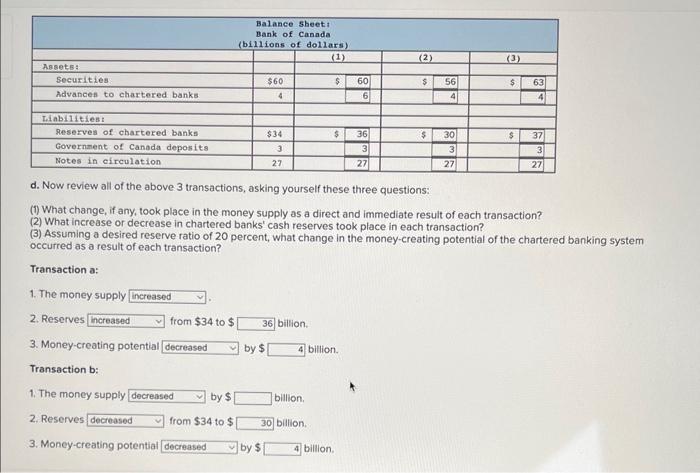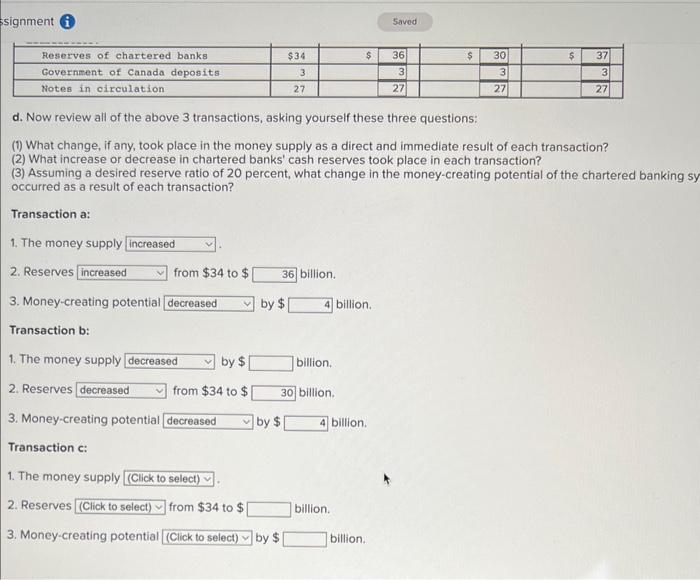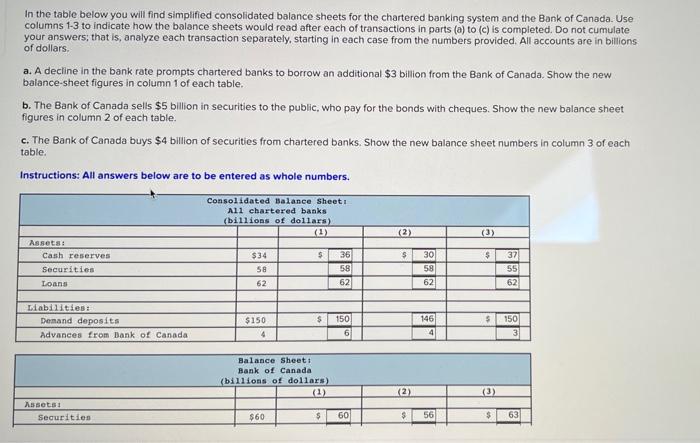In the table below you will find simplified consolidated balance sheets for the chartered banking system and the Bank of Canada. Use columns 1-3 to indicate how the balance sheets would read after each of transactions in parts (a) to (c) is completed. Do not cumulate your answers; that is, analyze each transaction separately, starting in each case from the numbers provided. All accounts are in billions of dollars. a. A decline in the bank rate prompts chartered banks to borrow an additional $3 billion from the Bank of Canada. Show the new balance-sheet figures in column 1 of each table. b. The Bank of Canada sells $5 billion in securities to the public, who pay for the bonds with cheques. Show the new balance sheet figures in column 2 of each table. c. The Bank of Canada buys $4 billion of securities from chartered banks. Show the new balance sheet numbers in column 3 of each table. Instructions: All answers below are to be entered as whole numbers. d. Now review all of the above 3 transactions, asking yourself these three questions: (1) What change, if any, took place in the money supply as a direct and immediate result of each transaction? (2) What increase or decrease in chartered banks' cash reserves took place in each transaction? (3) Assuming a desired reserve ratio of 20 percent, what change in the money-creating potential of the chartered banking system occurred as a result of each transaction? Transaction a: 1. The money supply 2. Reserves from $34 to $ billion. 3. Money-creating potential by $ bilion. Transaction b: 1. The money supply billion. 2. Reserves from $34 to $ billion. 3. Money-creating potential by $ billion. d. Now review all of the above 3 transactions, asking yourself these three questions: (1) What change, if any, took place in the money supply as a direct and immediate result of each transaction? (2) What increase or decrease in chartered banks' cash reserves took place in each transaction? (3) Assuming a desired reserve ratio of 20 percent, what change in the money-creating potential of the chartered banking sy occurred as a result of each transaction? Transaction a: 1. The money supply 2. Reserves from $34 to $ billion. 3. Money-creating potential by $ billion. Transaction b: 1. The money supply by $ billion. 2. Reserves from $34 to $ billion. 3. Money-creating potential by $ billion. Transaction c: 1. The money supply 2. Reserves from $34 to $ billion. 3. Money-creating potential by $ billion. In the table below you will find simplified consolidated balance sheets for the chartered banking system and the Bank of Canada. Use columns 1-3 to indicate how the balance sheets would read after each of transactions in parts (a) to (c) is completed. Do not cumulate your answers; that is, analyze each transaction separately, starting in each case from the numbers provided. All accounts are in billions of dollars. a. A decline in the bank rate prompts chartered banks to borrow an additional $3 billion from the Bank of Canada. Show the new balance-sheet figures in column 1 of each table. b. The Bank of Canada sells $5 billion in securities to the public, who pay for the bonds with cheques. Show the new balance sheet figures in column 2 of each table. c. The Bank of Canada buys $4 billion of securities from chartered banks. Show the new balance sheet numbers in column 3 of each table. Instructions: All answers below are to be entered as whole numbers. a. Now review all of the above 3 transactions, asking yourself these three questions: (1) What change, if any, took, place in the money supply as a direct and immediate result of each transaction? (2) What increase or decrease in chartered banks' cash reserves took place in each transaction? (3) Assuming a desired reserve ratio of 20 percent, what change in the money-creating potential of the chartered banking systern occurred as a result of each transaction? Transaction a: 1. The money supply 2. Reserves from $34 to $ billion. 3. Money-creating potential by $ billion. Transaction b: 1. The money supply bition. 2. Reserves from $34 to $ bilion. 3. Money creating potential by $ billion. d. Now review all of the above 3 transactions, asking yourself these three questions: (1) What change, if any, took place in the money supply as a direct and immediate result of each transaction? (2) What increase or decrease in chartered banks' cash reserves took place in each transaction? (3) Assuming a desired reserve ratio of 20 percent, what change in the money-creating potential of the chartered banking system occurred as a result of each transaction? Transaction a: 1. The money supply 2. Reserves from $34 to $ billion. 3. Money-creating potential by $ billion. Transaction b: 3. Money-creating potential by $ billion. Transaction c: 1. The money supply 2. Reserves from $34 to $ billion. 3. Money-creating potential by $ billion















